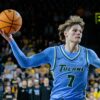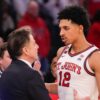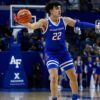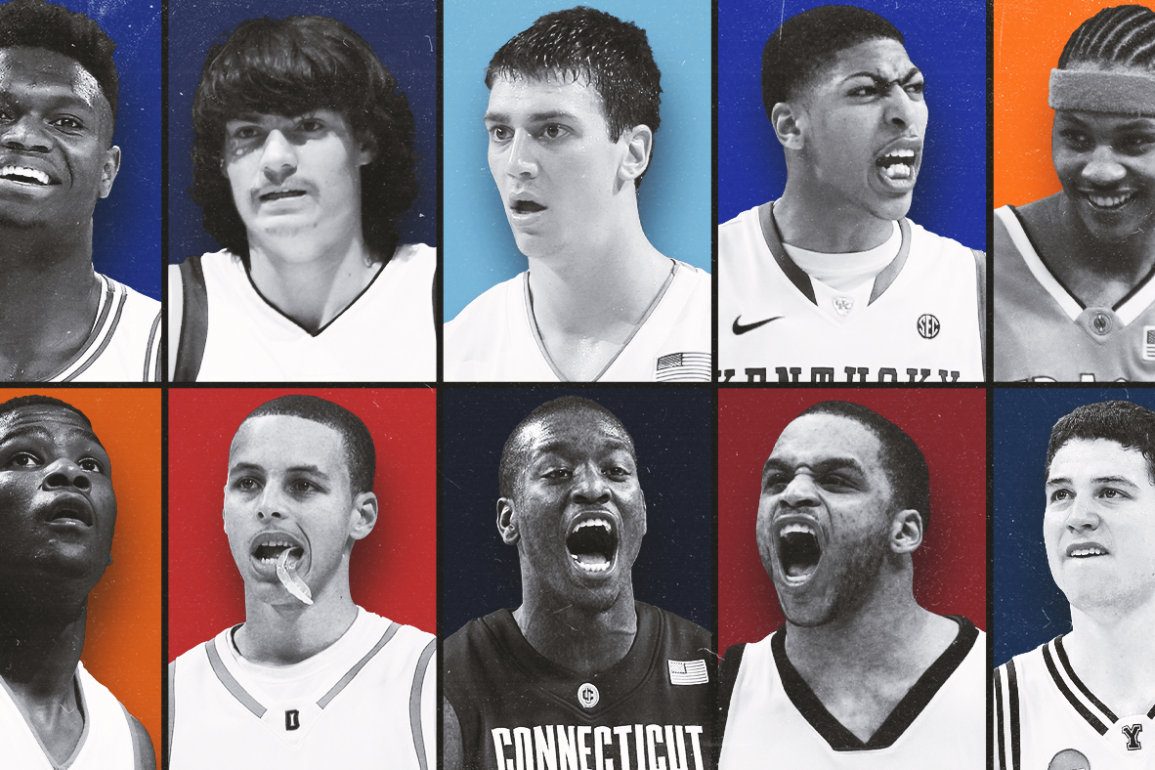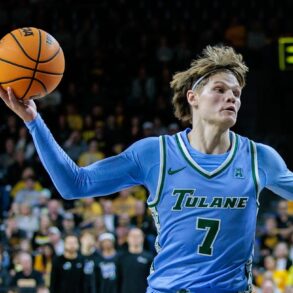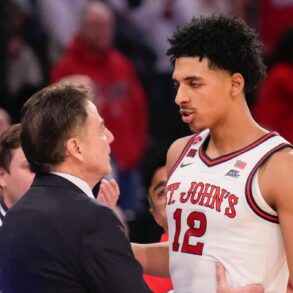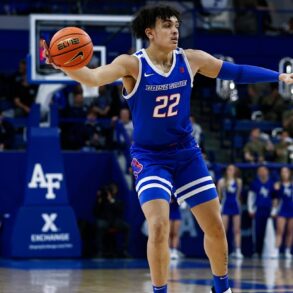
In 1965, before he was Kareem Abdul-Jabbar, an 18-year-old Lew Alcindor arrived at UCLA alongside Lucius Allen, Lynn Shackelford and Kenny Heitz, as ballyhooed a freshman class as the college ranks had ever seen. Freshmen couldn’t participate in varsity sports at the time, but those four, the “BruBabes,” led the freshman squad to a 75-60 scrimmage win over the varsity Bruins, the defending champs, in October of 1965.
The next year, with the BruBabes as sophomores, they went 30-0 and won the national title. As juniors, they went 29-1 and won the title. As seniors, they went 28-2 and — you guessed it — won the title.
We’ll never truly know what that foursome could have done as freshmen, but nearly 60 years later, we’re getting another historic freshman class, one that’s on the precipice of leading the another storied program to a championship. The Duke Blue Devils have an obvious headliner in Cooper Flagg, a can’t-miss prospect who has somehow exceeded monumental expectations. The list of impressive stats doesn’t do him justice, but here’s a smattering:
- First player in Division I history with 675 points, 250 rebounds, 150 assists, 50 steals and 40 blocks in a season
- First major-conference freshman to lead his team in all of those stats since Ben Simmons in 2015-16
- First player averaging 15 points, seven rebounds and five assists in the NCAA Tournament entering the Final Four since Grant Hill in 1994
- 18.9 points per game is third-most by a freshman on a Final Four team, behind only 2002-03 Carmelo Anthony and 1989-90 Kenny Anderson
- Highest KenPom Player of the Year Rating since Frank Kaminsky in 2014-15
Of course, Flagg’s greatest potential accomplishments, both for his team and as an individual, lie ahead. He could become the fourth freshman ever — joining Anthony (2003 Syracuse), Anthony Davis (2012 Kentucky) and Jahlil Okafor (2015 Duke) — to lead a national champion in scoring average. Individually, he could join Kevin Durant (2007 Texas), Davis and Zion Williamson (2019 Duke) as the only freshmen to win National Player of the Year.
He’s far from alone, though. Kon Knueppel had a team-high 21 points in the Elite Eight win over Alabama and became just the fourth freshman ever to have at least 20 points, five rebounds and five assists in an Elite Eight game. Khaman Maluach is shooting a preposterous 87% in the NCAA Tournament.
Add in the contributions of the sharp-shooting Isaiah Evans and backup big Patrick Ngongba, and you have quite the collection of first-year talent. Freshmen have scored 62% of Duke’s points this season, the third-highest percentage of any Final Four team in the last 50 years. The only ones higher are 2013-14 Kentucky at 82% and 1991-92 Michigan — aka the “Fab Five” — at 75%.
What do those two have in common? They lost in the national championship, a trend Duke’s youngsters hopes to end. If they do so, their five-man freshman class has a claim as the best ever. Here are some of the top contenders.
Classes to consider
2018-19 Duke
There are few words to describe Zion Williamson’s dominance. He was No. 1 in Matt Norlander’s top 25 college basketball stars of the past 25 years. His Player Efficiency Rating is the best by any freshman on record by a comically large margin.
That’s what makes his status as the third-best recruit in the class coming in even more hilarious. RJ Barrett (No. 1) and Cam Reddish (No. 3) came in ahead of Williams in the rankings, and the Blue Devils also had Tre Jones (No. 14) in tow. They introduced themselves to the basketball world at large with a 118-84 romp over No. 2 Kentucky to open the season.
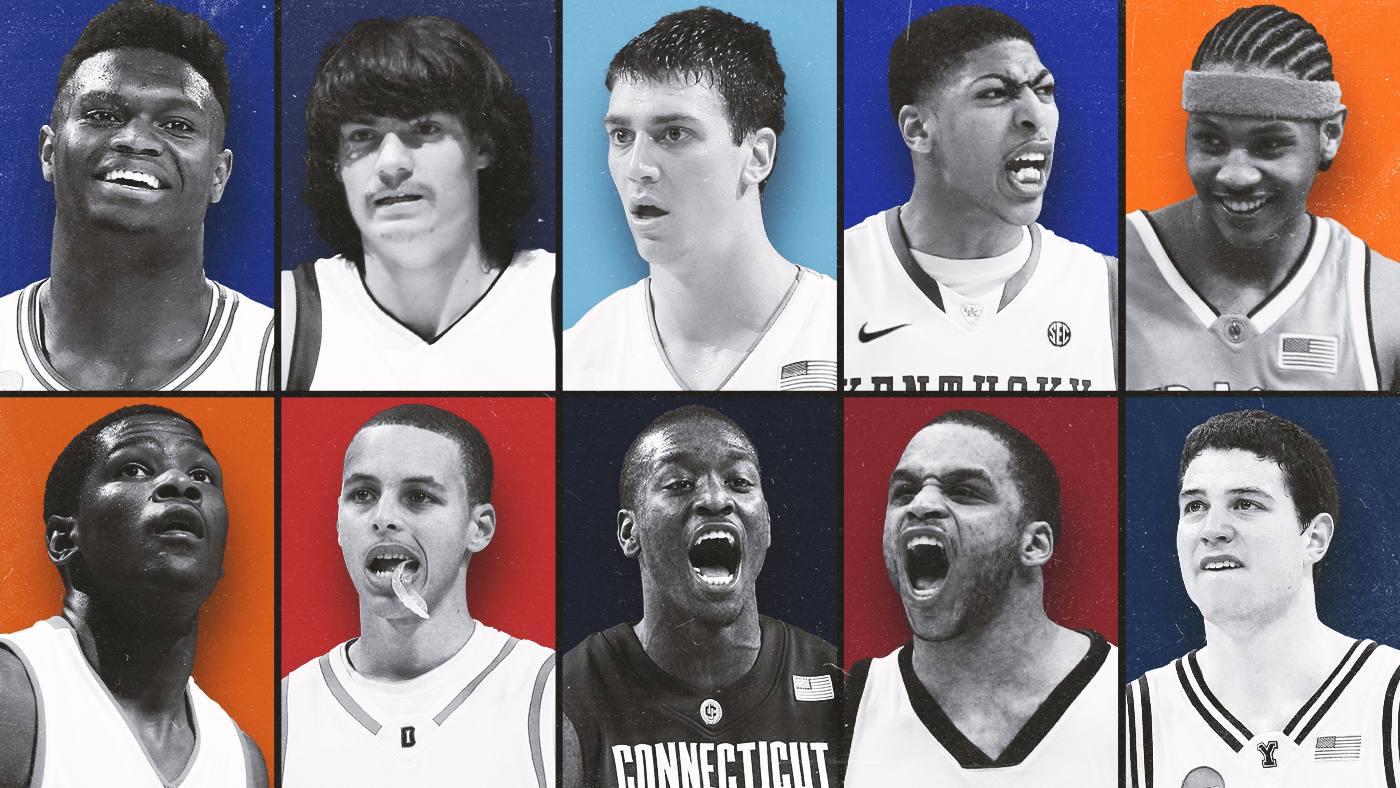
The end product, however, didn’t end up matching the individual brilliance. The Blue Devils rebounded from a third-place finish in the ACC regular season standings with a conference tournament title, but they were ousted by a savvy Michigan State team in the Elite Eight, with a combined 12 turnovers from Williamson and Barrett while Reddish shot just 2 of 8 off the bench. It was the second straight year a star-studded Duke freshman trio burnt out in the Elite Eight.
2014-15 Duke
The 2014-15 Blue Devils freshman trio of Okafor, Winslow and Jones was magnificent, and the title sets them apart from the team above. While Duke didn’t win the ACC regular-season or tournament crowns, it romped through much of the NCAA Tournament, winning four of its six games by double figures.
But the cherry on top was rallying past an excellent Wisconsin team in the title game behind 23 points from Jones and a stunning 16-point display from another freshman — little-used Grayson Allen, who scored 16 points off the bench after scoring 18 points in the first five games of the NCAA Tournament combined. If Allen doesn’t step up, Wisconsin’s holding up the trophy, and this Duke team isn’t on this list. Instead, it’s an all-time group, one still responsible for Duke’s most recent national title.
2013-14 Kentucky
How about this for freshmen depth: Julius Randle, James Young, twins Aaron and Andrew Harrison, Dakari Johnson and Marcus Lee. The first four were the team’s four top scorers.
Their March Madness run is an all-timer. The Wildcats were just 24-10 entering the NCAA Tournament, went just 12-6 in SEC regular-season play and lost to No. 1 Florida in the SEC Tournament title game.
Just a No. 8 seed in the NCAA Tournament, Kentucky ground out a first-round win over Kansas State before stunning No. 1 seed Wichita State 78-76 behind Randle, Young and the Harrisons combining for 65 points.
Then came a clutch run from Aaron Harrison that has been matched by few if any. In the Sweet 16, he hit a 3 with under a minute left to put Kentucky ahead of Louisville for good. In the Elite Eight, he hit a game-winning 3 with under three seconds left to beat Michigan, and in the Final Four, he hit a 3 with under six seconds left to beat Wisconsin.
These young Wildcats lost to UConn in the championship, but their rally from an up-and-down regular season — combined with Harrison’s heroics — constitute a very impressive run from a very, very young team.
2011-12 Kentucky
Davis’ freshman-year domination remains the stuff of legends. He blocked 4.7 shots per game, tops in the nation, while averaging 14.2 points and 10.4 rebounds on 62% shooting. No one has reached the 14/10/4 club since.
Davis was the headliner, but make no mistake: There was plenty of help. In the national championship, when Davis shot just 1 for 10, fellow freshmen Marquise Teague (14 points) and Michael Kidd-Gilchrist (11) stepped up. Winning the national championship gives this group a big boost, too.
Even beyond the title, though, this group has impressive numbers. How about a 38-2 record and a 16-0 SEC record? The Wildcats finished 10-0 against AP-ranked teams. Only four other teams have ever gone 10-0 or better against ranked teams, and none in this millennium.
Working against the 2011-12 Kentucky freshmen’s case is something it couldn’t control: the presence of some really good non-freshmen. Sophomore Doron Lamb had a game-high 22 points in the championship game and was the team’s second-leading scorer. Fellow sophomore Terrence Jones was the team’s third-leading scorer, and senior Darius Miller was also a major piece. Freshmen scored 54% of Kentucky’s points, slightly below the 2013-14 Kentucky and 1991-92 and 2024-25 Duke teams mentioned above. The Wildcats also didn’t win the SEC Tournament.
Still, it’s hard to find real faults with one of the best freshman seasons ever and two key contributors behind him; Kidd-Gilchrist was even a consensus second-team All-America selection. These Wildcats bring a strong case to the table.
2009-10 Kentucky
Getty Images
How good was this Kentucky class? The Wildcats had two one-and-done first-round picks — Eric Bledsoe and Daniel Orton — who weren’t even the best players at their position, behind John Wall and DeMarcus Cousins, respectively. Wall was a first-team All-America selection, and Cousins was second-team.
Kentucky won the SEC regular-season and tournament titles and waltzed through the first three rounds of the NCAA Tournament before falling to West Virginia after a brutal 4-for-32 performance from 3. The Wildcats still only lost by seven, leaving them as an immense “what if?” group.
2006-07 Ohio State
Led by the incomparable Greg Oden, Ohio State had a monstrous 2006-07 freshman class that included Mike Conley Jr., Daequan Cook and David Lighty. The Buckeyes went 35-4, reached the national championship and won the Big Ten regular-season and tournament titles. Oden was Anthony Davis before Anthony Davis, averaging 15.7 points, 9.6 rebounds and 3.3 blocks and leading the country in offensive rebounds in his lone collegiate season.
Whereas Davis won a national title despite playing poorly, Oden lost one despite playing well. “Well” doesn’t even cover it: He had 25 points, 12 rebounds and four blocks. But Ohio State shot just 4 for 23 and Florida was too much en route to its second straight title.
2002-03 Syracuse
Carmelo Anthony spent just one season at Syracuse, but that one season was more than enough to place him among the program greats. Averaging 22.2 points, Anthony became the first freshman to lead a national championship-winning team in points per game. He only earns that distinction, though, thanks to the contributions of fellow freshman Gerry McNamara, who had 19 points in a Final Four win over Texas and 18 in the title game win over Kansas. Syracuse also got nine points per game from freshman Billy Edelin and became the first title-winning team to get at least half of its points from freshmen.
Syracuse went 30-5 overall and won the regular-season Big East title. As with some of the other freshman classes we’ve mentioned, the national title places this group in rare air.
1991-92 Michigan
The “Fab Five” revolutionized the sport and the culture surrounding it. The Wolverines’ top four scorers — Jalen Rose, Chris Webber, Juwan Howard and Jimmy King — were freshmen who would go onto the NBA. Webber (15.5 points, 10 rebounds) was the first Big Ten freshman to average a double-double in more than a decade, and Rose’s 17.6 points per game were also the best by a Big Ten freshman in over a decade.
The Wolverines endured an inconsistent regular season and finished just 11-7 in Big Ten play. Once the NCAA Tournament arrived, though, they put together some excellent play, pulling upsets over Oklahoma State, Ohio State and Cincinnati to become just the third No. 6 seed or worse to advance to the national championship since the 1985 expansion to 64 teams.
Once there, though, Michigan got thumped 71-51 by Grant Hill, Christian Laettner and Duke, ending the most iconic freshman group performance to date.
How does 2024-25 Duke stack up?
Perhaps the biggest feather in this year’s Duke freshmen is their all-around excellence. The Blue Devils have the second-best net ranking in KenPom history, which dates back to 1996-97.
Some counting numbers might not be as gaudy as they could be because Duke has simply trounced so many opponents, but advanced metrics paint the picture of an absolutely dominant three-headed monster.
Let’s use Win Shares, a Bill James baseball invention that’s been translated to basketball to try to “divvy up credit for team success to the individuals on the team.” Since 2002-03, only four teams have had three freshmen record at least five Win Shares in a season. Duke is one of them.
|
3 freshmen with 5+ Win Shares since 2002-03 |
|
|
2024-25 Duke |
Cooper Flagg, Kon Knueppel, Khaman Maluach |
|
2017-18 Duke |
Marvin Bagley III, Wendell Carter Jr., Gary Trent Jr. |
|
2016-17 Kentucky |
Malik Monk, Bam Adebayo, De’Aaron Fox |
|
2014-15 Duke |
Jahlil Okafor, Tyus Jones, Justise Winslow |
Furthermore, the 2024-25 group’s 20.1 total Win Shares is the most of any of the above groups, led by Flagg’s 8.1 — most by a freshman since Zion Williamson in 2018-19.
But when Flagg missed almost all of the conference tournament, Knueppel stepped up to the tune of 21 points per game to earn ACC Tournament MVP.
Another major strength is the group’s fit. Flagg does just about everything on both ends. Knueppel is a versatile, skilled scorer shooting over 40% from 3. Maluach provides strong rim protection and reliable finishing; his 76% shooting is seventh in Division I. Evans is a sniper from long range (42%). It’s the perfect group for the modern game, one that’s able to adapt and destroy all types of opposing playing styles.
At the moment, Duke’s freshman class stacks up favorably to any that didn’t win a national championship. Few freshman groups have put together the pre-NCAA Tournament these Blue Devils have, and in Flagg, they have a true superstar, while in Knueppel and Maluach they have stars who are soon-to-be lottery picks.
The fact that this team has made the Final Four is a major feather in its cap, though a title like the ones 2014-15 Duke, 2011-12 Kentucky and 2002-03 Syracuse captured would put it in a different stratosphere. For now, it’s fair to say Duke’s freshman class is among the best ever, and there’s still time to join the pantheon of all-time greats … and maybe climb to the top of that group, too.
This post was originally published on this site be sure to check out more of their content.


